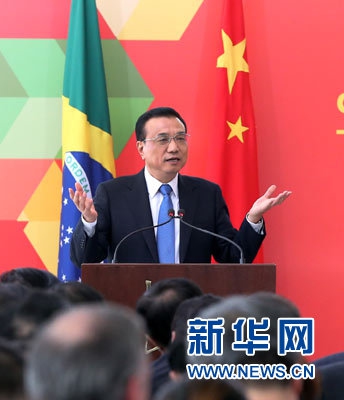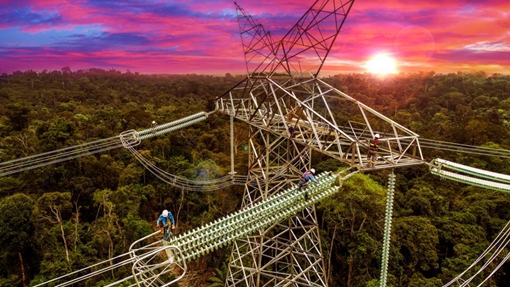




- BRNN
- BRI News
- BRNN News
- Database
Official Documents Polices and Regulations
Inter-government Documents International Cooperation BRI Countries
Business Guide Economic Data BRI Data
Trade
Investment Projects Latest projects
Cases - Content Pool
On the vast tropical land of Brazil stand soaring lattice towers with crisscrossing power lines. They belong to the Belo Monte phase II ultra-high-voltage (UHV) transmission project—a project invested, constructed and operated by the State Grid Corporation of China (SGCC). On May 19, 2015, the visiting Premier Li Keqiang and then Brazilian President Dilma Rousseff attended at the Presidential Palace in Brasília the project's groundbreaking ceremony via video link. Witnessed by the Chinese and Brazilian leaders, the Belo Monte project started its marvelous journey.

On May 19, 2015, Premier Li Keqiang attending the project’s groundbreaking ceremony via video link
While 80 percent of Brazil's electricity is used by the more developed areas in southern and southeastern parts of the country, main power plants are located in the north, more than 2,000 kilometers away. The fast growing demand for electricity calls for a "power expressway" to transmit the power generated in Belo Monte to southeast Brazil. From the various international bidders for the project, the SGCC stood out and won with its UHV technologies, rich experience and localization project management. The construction officially started in September 2017. Running over 2,500 kilometers through 81 cities in five states from north to south, the project involves the world's longest ±800kV ultra-high-voltage direct current (UHVDC) transmission line. It is also a concrete example of Belt and Road cooperation between China and Latin America.
Behind the great success of this project is the hard work of many Chinese and Brazilian workers. The transmission line navigates difficult terrain—three regions with very different topography and climate, including 13 big rivers. The complex ecological system and great cultural diversity along the line made things still more difficult for a company operating on foreign soil. Yet the Chinese and Brazilian workers rose to their tasks. They adapted China's UHV technologies to the challenging environment and other local circumstances, braved high temperatures, strong winds, thunderstorms and other severe weather events, and worked at full capacity. The project was put into operation 100 days ahead of schedule, creating the miracle of zero safety accidents and zero defects in Brazil's history of large power projects.

The Belo Monte phase II ultra-high-voltage (UHV) transmission project
The Belo Monte phase II project is the first overseas project using Chinese UHV technologies. It has become a signature project under the Belt and Road Initiative and showcases the image of Chinese companies in Latin America. In setting up the transmission line, detours were taken to avoid nature reserves, and adjustments were made in light of the situation on the ground to meet environmental regulations, such as by increasing the towers' height and spacing, despite additional costs. Wounded animals found on the construction sites were taken to nearby vets, treated and released back into the wild. Brazilian experts were invited to conduct environmental monitoring and assess the landscape, flora and fauna, and historical and cultural sites along the route to help minimize the project's environmental impact. These efforts were highly commended by Brazil's environmental protection agency.
Built under the principle of extensive consultation, joint contribution and shared benefits, the Belo Monte phase II project has contributed to the economic and social development of the local communities and delivered benefits to both China and Brazil. The project has created 16,000 local jobs, added 2.2 billion reais to tax revenue, and benefited a total of 22 million Brazilians. Along the transmission line, China has built and renovated 1,970 kilometers of roads and 350 bridges, carried out more than 20 corporate social responsibility programs, and donated malaria control supplies to 33 cities. This project has also enhanced the technological and personnel exchanges between the two countries, and boosted the confidence of Chinese businesses to invest in Brazil and the wider Latin America.
As a Chinese saying goes, "A bosom friend afar brings a distant land near." Despite the geographic distance between the two sides, China and Latin America share a long history of interactions and a reservoir of goodwill. Relations between China and Latin America and the Caribbean (LAC) countries have now entered a new era of all-round development. In the new development paradigm of "dual circulations" that China is actively pursuing, LAC countries' participation is indispensable. China and LAC countries have started a new journey toward a community with a shared future. Guided by the principle of equality and mutual benefit, China-LAC relations will continue to make new progress and deliver more benefits to the people of both sides. This trans-Pacific friendship will certainly grow from strength to strength.

Tel:86-10-65368972, 86-10-65369967